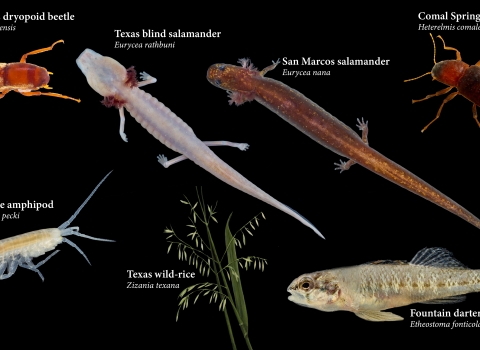The story of endangered species conservation in the United States over the past 40 years involves many heroes. This year the U.S. Fish and Wildlife Service (Service) recognized 61 of these heroes for their outstanding efforts to conserve and protect endangered and threatened fish, wildlife and plants by designating them 2012 Recovery Champions. Among those honored were two southwestern teams - the Gila Trout and Chihuahua Chub Recovery Team and the New Mexico Chiricahua Leopard Frog Conservation Working Group.
“Recovery Champion awards acknowledge individuals and groups who have excelled in their efforts to protect and recover our most imperiled species,” said Service Director Dan Ashe. “They exemplify the dedication and determination that has helped save countless animals and plants from extinction and that continues to raise the bar in the field of endangered species conservation.”
“I am very pleased to see the important accomplishments made by our Gila Trout and Chihuahua Chub Recovery Team being acknowledged with this award,” said Benjamin Tuggle, U.S. Fish and Wildlife Service Southwest Regional Director. “Additionally, I take great pleasure in acknowledging the significant contribution made by an important conservation partner, the New Mexico Chiricahua Leopard Frog Conservation Working Group, who have made substantial advances toward the recovery of this species in New Mexico. With this period of severe drought and increasing fire danger in the Southwest, their work is timely and extremely valuable.”
The Gila Trout and Chihuahua Chub Recovery Team is being recognized as 2012 Recovery Champions for rescuing Gila trout, spikedace, loach minnow, Gila chub, headwater chub and others during the Whitewater Baldy Complex Wildfire, one of the worst in New Mexico’s history. The team’s quick action prevented catastrophic fish losses during a three-month long event that burned almost 300,000 acres.
This action required an intense, multi-agency initiative. Pushed by the monsoon rain season, crews raced to the scene as mud and ash flows threatened to kill fish and bury habitat. Aware of potential flooding and unstable trees, crews entered dangerous areas on horseback and by helicopter, saving as many as 300 fish.
Today, these fish are doing well in Arizona streams and Service facilities. Gila trout populations have actually increased, and all four lineages are represented in the National Fish Hatchery System. Evacuated to the Southwest Aquatic Resources Center in Dexter, New Mexico, spikedace, loach minnow, Gila chub, and headwater chub ensure genetic diversity that is now protected.
Active for two decades, this longest-serving recovery team in Region 2 has developed and implemented an emergency plan, responded to wildfires, and treated non-native salmonid invasions, benefiting many species.
The New Mexico Chiricahua Leopard Frog Conservation Working Group is also being recognized as 2012 Recovery Champions for the emergency actions that they undertook, reversing the downward spiral of this species in the state from trending towards extinction—projected within a decade—toward recovery in New Mexico.
By 2008, disease and non-native predators had eliminated almost two-thirds of the Chiricahua leopard frog populations in New Mexico, and many that survived consisted of very few frogs. With only a limited budget and a small group of people, this team combined an eagerness to do what needed to be done with creative options, including back yard frog tanks and a “ranarium.” This approach rescued four populations, established a new wild population on private land, augmented two others, and reintroduced the species at three locations.
This team has secured the remaining genetic lineages of the Chiricahua leopard frog, created refugia populations of all populations, and started a multi-faceted program of captive-breeding and head-starting that involves federal and state agencies, the academic community, private partners, and non-governmental organizations as stakeholders. This success is a tribute to the enthusiasm of individual members, who have devoted their resources and their time to conservation. The team’s initiatives have changed conversations from stopping losses to advancing recovery.
The Recovery Champion awards began in 2002 as a one-time recognition for Service staff members for their achievements in conserving listed species. However, in 2007, the program was expanded to honor Service partners as well, recognizing their essential role in the recovery of threatened and endangered species.
For information about the 2012 Recovery Champions, please visit: http://www.fws.gov/endangered/what-we-do/recovery-champions/index.html.
America’s fish, wildlife and plant resources belong to all of us, and ensuring the health of imperiled species is a shared responsibility. To learn more about the Service’s Endangered Species program, go to http://www.fws.gov/endangered/.
Connect with our Facebook page at www.facebook.com/usfws, follow our tweets at www.twitter.com/usfwshq, watch our YouTube Channel at http://www.youtube.com/usfws and download photos from our Flickr page at http://www.flickr.com/photos/usfwshq.
-FWS-
http://www.fws.gov/southwest



